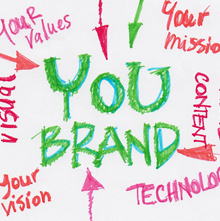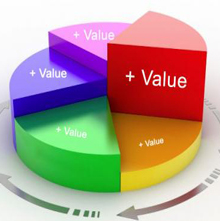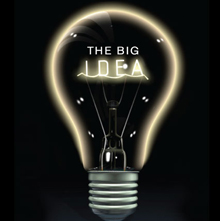WHAT IS BRANDING? and HOW IT WORKS
This article will cover:
- The word branding?
- How the web has changed the relationship with customers
- How branding can help your business
- The key ingredients of any good brand
- How to communicate, manage and develop your brand identity
- Branding for different market sectors
- The relationship between design and branding

The word "Branding" ?
Brand and branding can mean all sorts of things to different people and in different contexts.
The simplest answer to what is branding is that, it is a set of associations that a person (or group of people) makes with a company, product, service, individual or organisation.
These associations may be international - that is, they may be actively promoted via marketing and corporate identity, or they may be outside the company's control. For example, a poor press review for a new product might harm the product manufacturer's overall brand by placing negative associations in people's minds.
To illustrate, the best-known product, brand, in the world is: Coca-Cola.
Although essentially just a soft drinks product, Coca-Cola the drink is eclipsed by the sheer might of Coca-Cola the brand. This phenomenon is best summed up by the following quote from a Coca-Cola executive:
"If Coca Cola were to lose all of its production-related assests in a disaster, the Company would survie."
"By contrast, if all consumers were to have a sudden lapse of memory and forget everything related to Coca-Cola, the company would go out of business."
- Coca-Cola Executive -

In 2007 a survey was conducted by Interbrand to show the value of global brands. It showed that Coca-Cola's brand equity was valued at US$65.3bn, just under half the company's true market value.
So what are these all-powerful associations? For Coca-Cola, typical perceptions might be that it is the original cola drink ('The Real Thing'), that its recipe is secret and unsurpassed, that it's all-American or maybe global, that it's youthful, energetic, refreshing and so on. Visual associations might include the unmistakable red and white logo and corporate colours, or the unique shape and tint of the original glass bottles.
These are mostly positive brand associations, but there may be negative ones too. For example, Coca-Cola may be seen as unhealthy, or as a symbol of global imperialism by American brands. What is seen as a positive association to some may be unpleasant to others and negative perceptions could become attached to a brand’s identity even if the company strives to present a different character.
Of course, brands aren’t limited to the food and drink category. If a brand is just a set of associations then practically anything could be said to have a brand, even individuals – think Simon Cowell or Gordon Ramsay.
In fact, Ramsay's own brand is so strong, that in 2007 he leant his weight to a major advertising campaign by Gordon's Gin. He was chosen not just because of his name, but because his association with a sense of quality and exclusivity mirrors the drinks manufacturer's own brand values.
Other high-profile examples of recognised brands include Toyota, British Airways, Tate, Amazon, Save the Children, Burberry, HMRC or even London. From services to cities, products to publications, each carries a strong set of associations in the minds of a large number of people.

What is Branding?
If a brand results from a set of associations and perceptions in people’s minds, then branding is an attempt to harness, generate, influence and control these associations to help the business perform better. Any organisation can benefit enormously by creating a brand that presents the company as distinctive, trusted, exciting, reliable or whichever attributes are appropriate to that business.
While absolute control over a brand is not possible due to outside influences, intelligent use of design, advertising, marketing, service proposition, corporate culture and so on can all really help to generate associations in people’s minds that will benefit the organisation. In different industry sectors the audiences, competitors, delivery and service aspects of branding may differ, but the basic principle of being clear about what you stand for always applies.

How brands are changing
In the last few years the digital communications revolution has completely transformed this balance of control. The consumer's voice has become louder and much more public. Consumers can publish their experience of a brand and compare it with the experience of others. The ability of a brand to respond to this can have a profound affect on the way they are perceived. It's also affecting the types of brand that achieve prominence. There is even a thriving market in brands whose primary strategy is to champion the consumer's voice, Tripadvisor is one of the most famous of these(or infamous depending on your point of view).
Let's return to Coca-Cola briefly. After 13 years of dominance in 2013 they were knocked off the top spot in Interbrand's influential listing of the leading 100 global brands. The two brands that overtook it were indicative of the way the world has changed. At number one was Apple, and at number two - Google. Both companies rooted in technological innovation, but perhaps more importantly both brands that are focussed on providing a products and services, that make people's lives easier.
Apple's transformation from a computer manufacturer to a media giant didn't happen just because of the introduction of the iPod and iPhone. It happened because they developed revolutionary new services around those products - iTunes and the App Store. They thought very hard about their customer and what would make their life easier. Whilst Google has started to develop hardware products it's brand is rooted in its incredibly popular search service.
Both those brands are resolutely customer-focussed, and great branding and responsive behaviour allowed them to build the right kinds of connections with the their customers to thrive. Although eclipsed by the two technology giants on that particular chart, Coke too continues to use its brand clout to create the closer connections with people that todays communications landscape demands. A great example of that is the 'Share a Coke' campaign they launched in the Summer of 2013, allowing people to buy a bottle of Coke with their name on.

Why do you need a brand?
Branding can help you stand out from your competitors, add value to your offer and engage with your customers.

Creating difference
Branding is a way of clearly highlighting what makes your offer different to, and more desirable than, anyone else’s. Effective branding elevates a product or organisation from being just one commodity amongst many identical commodities, to become something with a unique character and promise. It can create an emotional resonance in the minds of consumers who choose products and services using both emotional and pragmatic judgements.
Rachel’s Organic Butter, for example, chose black for its packaging design so it would stand out from the typical yellow, gold and green colours (representing sunshine and fields) used by competitor products. The result is that the brand appears more premium, distinctive and perhaps even more daring than its competitors.

Adding value
People are generally willing to pay more for a branded product than they are for something which is largely unbranded. And a brand can be extended through a whole range of offers too.
Tesco, for example, began life as an economy supermarket and now sells a wide range of products, from furniture to insurance. But a consistent application of the Tesco brand attributes, such as ease of access and low price, has allowed the business to move into new market sectors without changing its core brand identity.
This obviously adds value to the business, but consumers also see added value in the new services thanks to their existing associations with the Tesco brand. Of course, this can work in reverse too: if consumers don’t like the Tesco brand in one product area, they’re less likely to choose the company’s offer in another product area.

Connecting with people
Creating a connection with people is important for all organisations and a brand can embody attributes which consumers will feel drawn to.
Apple’s original launch of the iPod, for example, catapulted the company from computer business to mass-market entertainment brand, with iPod marketing drawing heavily on people’s emotional relationship with their music.
By moving into music and film, Apple redefined what the company did and shifted its brand association to something that connects with larger numbers of people outside computing or creative community. They continued this shift with introduction of the iPhone, iPad and App Store bringing portable computing and its software into mainstream consumer culture. In doing so the brand has become more and more entwined on the lives of consumers making it incredibly powerful.
The Key ingredients of any brand
In this section we outline the four cornerstones of any good brand using from the business world

Defining your brand
If you’re thinking about how to rebrand your business, its products or services, or if you want to assess where your brand stands at present, there are a few key aspects you should consider:
- The big idea – what lies at the heart of your company?
- Values – what do you believe in?Vision – where are you going?
- Personality – how do you want to come across?
If you can start to answer these questions with clarity and consistency then you have the basis for developing a strong brand.
Let’s take each of these in turn.

The Big Idea
The big idea is perhaps a catch-all for your company or service. It should encapsulate what makes you different, what you offer, why you’re doing it and how you’re going to present it. The other ingredients are slightly more specific, but they should all feed from the big idea.
The big idea is also a uniting concept that can hold together an otherwise disparate set of activities. Ideally, it will inform everything you do, big or small, including customer service, advertising, a website order form, staff uniforms, corporate identity, perhaps right down to your answer machine message.
To pin down your own big idea you will need to look very carefully at your own business and the marketplace around you, asking these types of questions:
- How can you stand out?
- What is your offer?
- What makes you different?
- What is your ‘personality’?
- What do consumers want or need?Is there a gap in the market?
To aid this process it’s usually very helpful to get an outside perspective on things too, so consider working with a management consultant, business development consultant or design consultancy.
Once decided, the articulation of these ideas can be put into action through branding techniques such as design, advertising, events, partnerships, staff training and so on. It is these activities that set up the consumer’s understanding and expectation of your company; in other words, its brand. And once you’ve set up this brand ‘promise’, the most important thing is to ensure that your products and services consistently deliver on it.
IKEA: the big idea
IKEA is good example of a company with a big idea. Its brand is based around the notion that good design is for everyone, not just design snobs. Past campaigns have urged us to ‘chuck out the chintz’ and fit out our homes with well-designed furniture and products at affordable prices.
Their branding plays on this central idea of the democratisation of design. In the last few years they have created advertisements featuring house parties in IKEA homes, campaigns where customers could appear on the front cover of their own IKEA catalogue and in 2013 they demonstrated their commitment to providing design for everywhere even the smallest spaces with the smallest IKEA store in the world.
In stores, products are given individual names and customers stack up their trolleys from the warehouse themselves (saving IKEA money in the meantime). This is all in keeping with the idea that you don’t need specialist, privileged knowledge to go out and buy good design.

Vision
Generating a vision for your company means thinking about the future, where you want to be, looking at ways to challenge the market or transform a sector. A vision may be grand and large-scale, or may be as simple as offering an existing product in a completely new way, or even changing the emphasis of your business from one core area to another.
Although corporate visions and mission statements can often appear to be little more than a hollow dictums from top management, a well-considered vision can help you to structure some of the more practical issues of putting a development strategy into action. If you’re clear on what you’re aiming at, it’s obviously easier to put the structures in place to get there.
Microsoft: vision
An example of vision on a large scale comes from Microsoft chairman Bill Gates, who knew exactly where he was going with his company even in the early days.
And this comes from a company which until 2013 had never actually made computers. The vision lies in seeing where the market is going and asking where you want to be: in this case, providing the operating software for the computers that sit in offices and homes around the world.
The Microsoft brand which resulted is inextricably linked with computing. Most PCs come with Windows as standard, even though the computer hardware can be run with a number of different operating systems.
"We started with a vision of a computer on every desk and in every home… every day, we’re finding new ways for technology to enhance and enrich people’s lives. We’re really only just getting started"
Bill Gates, Microsoft Chairman

Values
Like the word brand itself, the term brand values is perhaps a little over-used in design and marketing circles, but it does relate to important aspects of how people see your organisation. It’s what you stand for and it can be communicated either explicitly or implicitly in what you do. But imbuing your company’s brand with a set of values is tricky for a number of reasons.
Firstly, everybody wants the same kinds of values to be associated with their business. A survey by The Research Business International (now part of Synovate) found that most companies share the same ten values, namely: quality, openness, innovation, individual responsibility, fairness, respect for the individual, empowerment, passion, flexibility, teamwork and pride.
Secondly, it’s not easy to communicate values: overt marketing may seem disingenuous, while not communicating your values in any way may result in people not seeing what you stand for. And lastly, any values you portray have to be genuine and upheld in the way your organisation operates. Branding and design consultants can help you clarify what your organisation or business stands for and then they can develop ways for you to communicate that effectively. This might be through graphic design, language, advertising, staff training, the materials used in product manufacture and so on.
Branding and design consultants can help you clarify what your organisation or business stands for and then they can develop ways for you to communicate that effectively. This might be through graphic design, language, advertising, staff training, the materials used in product manufacture and so on.
Pret A Manger: values
Pret A Manger makes a big play of valuing fresh food and minimising wastage. So, all its food is made on location each morning (with no sell by dates) and any left over at the end of the day is given to homeless charities and shelters.
In this way the company has laid out a value and has followed it through with the way it runs its service.
Burberry: rediscovering values
Burberry is an example of a brand that for a while, lost it's core values and was beginning to underperform.
Originally a luxury manufacturer of raincoats it had become near ubiquitous. The famous Burberry check was appearing on everything from dog leashes to t-shirts. Consistency of the brand had been lost, with customers around the world getting a different experience. In 2006 new CEO Angela Ahrendts brought luxury firmly back to the agenda, appointed a single creative director to oversee the brand worldwide and ruthlessly cut away the baggage that had begun to attach itself to the brand reducing the product line back to the luxury, high-end of the market. Coupled with a creative and considered use of new technology this has resulted in the revenue of the company rising from $1190 million in 2006 to over $3000 million in 2012.

Personality
Once you have established your ‘big idea’, vision and values, they can be communicated to consumers through a range of channels. The way you decide to present this communication – the tone, language and design, for example – can be said to be the personality of your company.
Personality traits could be efficient and businesslike, friendly and chatty, or perhaps humorous and irreverent, although they would obviously have to be appropriate to the type of product or service you are selling.
It need not have anything at all to do with the personalities of the people running the company; although it could, if you want to create a personality-driven company in the way that Richard Branson is very much the figurehead for Virgin.
And for smaller companies, the culture and style of the business can often reflect the founder, so its values and personality may be the same.
Here are a few examples of how you can start to control the elements of your company’s personality, conveying certain aspects to customers in different ways:
- Graphic design: The visual identity – hard corporate identity or soft, friendly caricature?
- Tone of voice: Is the language you use (both spoken and written) formal or relaxed?
- Dialogue: Can your users or customers contribute ideas and get involved in the organisation? Or is it a one-way communication?
- Customer service: How are staff trained to communicate with customers? What level of customer service do you provide?
As companies grow, their personality and values are reflected more in internal culture and behaviour than through the characteristics of the founders. This personality then defines how the companies express their offer in the market.

Putting it all together
Using the key ingredients that we’ve outlined here – and bringing in consultants to help you define and implement them – will give you a solid understanding of your organisation’s brand, as well as strategies on how to present it to people. Starting with the big idea, you can then go on to refine and set out your company’s vision, values and personality. And once these are all in place, you can think about hiring designers to turn your brand blueprint into tangible communications.
Brand Management Techniques
Once your encompassing brand ‘promise’ is in place, you need to consider how you will communicate it and then how you will manage and develop it over time.
When it comes to communicating your brand to the public, there are a few techniques and issues that are worth considering:
Storytelling
An established technique in branding a business is to tell its story through communication elements such as corporate identity, packaging, stationery, marketing materials and so on. This can be quite low key, but it paints a picture of the provenance of the company and its products.
Sheffield butcher John Crawshaw, for example, hand-picks the meat sold in his three shops, whilst most of his competitors have their meat delivered in vacuum packs from an abattoir.
So, to illustrate this aspect of his service - or brand offer - a logo showing a butcher carrying a carcass over his shoulder was designed for Crawshaw’s business.
Credibility
The credibility of your brand’s offer must also be solid. For example, a Yorkshire drainage company called Naylor launched a range of lifetime-guaranteed flower pots, but the Naylor brand was inappropriate to market this range because it was associated too directly with the drainage side of the business. So the company set up a new brand called Yorkshire Flowerpots, with its own tone of voice, personality and visual identity so that it could sell the products with greater credibility.
Differentiation
A great deal of branding is about defining and presenting a point of differentiation in the sector you’re operating in. Get this right and your organisation will stand out brightly against your competitors.
Construction company Hilti provides an example of differentiation in a sector. Whilst most other construction companies use technical images of buildings and products in their communications, Hilti emphasised its relationship with the people involved in construction, showing black and white photographs of workers using Hilti tools, which are highlighted in the company’s corporate red.
Engaging with customers
Part and parcel of creating differentiation is engaging with your customers or users. If you stand out of the crowd for positive reasons and your tone of voice and communications are credible customers will look at what you’ve got to say.
When Orange launched in the mobile phone market in 1994, its identity, language and offer were very distinctive from its established rivals. It presented an optimistic vision of the future based on technology, but from a human rather than technical point of view. Its logo and name were abstract, creating stand out against BT Cellnet, T-Mobile and Vodafone, and its services were organised into simple talk plan packages.
For over a decade, this approach has remained more or less unchanged. For instance, the 2008 Orange campaign revolved around the slogan 'I am who I am because of everyone'. Adverts featured a series of individuals (including recognised entrepreneurs, artists and writers) listing the people that have most influenced the course of their lives.
By appealing to everyone's sense of individualism and focusing on the value of human interaction and communication rather than competitive price plans or the latest technology, Orange are able to extol the benefits of their service without ever having to mention mobile telephones.
Focusing your product portfolio
If you have a number of different products or services it may help to consider how you can streamline or organise them to make the offer easy for consumers to understand. Sometimes, the logic of internal company structures can dictate how a product offer is organised, but this does not necessarily make sense to an external customer. So think carefully about the best way to present what you do, even if it means setting things up differently from your internal organisation.
Rationalisation of products or services might also allow you to focus your investments more efficiently. After working with Design Council, household cleaning product manufacturer Challs shifted its focus to four key products, rather than the 92 it had previously been promoting.
Multiple brands and brand 'stretch'
If your company operates in more than one sector you will have to consider how you present the business in each area. One approach, as illustrated by Virgin, EasyGroup and Tesco, is to have a single brand identity which is applied to sub-brands for the areas you operate in. So we have Virgin Money and Virgin Atlantic, Easy Pizza and Easy Cruise, Tesco Entertainment and Tesco Finance and so on.
Just how far you can ‘stretch’ your primary brand in this way depends on the core ideas, values and associations you have to start with. In some cases it may actually be more effective to develop a completely distinct brand for the different sectors you want to operate it, rather than stretch your existing brand to meet new markets. As mentioned above, for Naylor’s flower pot business it made more sense to set up a dedicated brand called Yorkshire Flowerpots than to associate it with the existing Naylor drainage business.
There have been some notable and high-profile failures when it comes to brand stretch. A natural cleaning vinegar launched by Heinz bombed as a product because people associate Heinz with food, not cleaning. Harley Davidson (over-)extended its range to include perfume. This failed because it was perceived as being at odds with the Harley Davidson brand values of masculinity and strength.
Endorsed brands
A slightly more sophisticated possibility is to set up ‘endorsed’ brands. This is where you create a new brand in its own right but allow the ‘parent’ brand of your main company to feature as an endorsement of the new brand. Playstation, for example, is a powerful brand in its own right, but it has always been endorsed as Sony Playstation, leveraging the reputation of Sony Corporation.
Reinvigorating your brand
Whatever sector your work in, keeping your communications fresh is essential. Using designers to help reassess your designs, language or identity every few years should be seen as an ongoing investment in your company rather than a costly extra.
All successful companies revisit their communications periodically, even the world's most recognisable brands. But reinvigorating your brand doesn’t necessarily mean you have to start from the very beginning, reconsidering your big idea or vision and so on.
Take Coca-Cola for instance. They are constantly reviewing all aspects of their brand and refreshing them. In 2007 they commissioned design agency Turner Duckworth to produce a range of new packaging designs that would breathe new life into the cornerstones of Coke's visual identity; the classic logo, the contour bottle and the use of red and white. In 2009 they launched a new strap line 'Open Happiness' and in 2013 they created personalised labels for their bottles.
If you're happy with your company's big idea, vision and personality, these things can remain the foundations of what you’re doing - but the implementation of your brand should be refreshed to keep things on track and ensure it remains relevant to your target audience.
Naming
Brand names are an important aspect in setting the tone and personality of your brand, as well as being a key element in marketing activity. Along with design and tone of voice, a name can be a means of differentiation and should reflect the overall brand strategy you’ve developed.
Choosing a name can be a difficult task in itself, but it’s made even harder because so many are already in use and trademarked. By sure to check carefully that any names you’re considering for a company, product or service aren’t already in use and protected by law.
On the whole, a name falls into one of a few types, which can be arranged along a kind of spectrum of attributes.
These attributes are:
Descriptive
Names which simply say what the company/brand does. For example:
- Easyjet – makes flying easy
- Toys ‘R’ Us – is all about toys
- AA (Automobile Association) – is for motorists
Evocative
Names which suggest associations to the brand but do not try to describe the offer precisely. For example:
- First Direct – first bank to offer instant telephone banking
- Innocent – natural purity of the fruit juice
Abstract
Names that break sector rules and stand out. They make no clear reference to the nature of the business. For example:
- Google – quirky, accessible, positive and suggests curiosity
- Aviva – an invented name than suggests dynamism and movement
- Toast – suggests familiarity and warmth
Consistency
In branding and brand management a lot of importance is placed on achieving consistency, so that the same attributes and characteristics are evident in all areas of the business’ operations. Essentially, 'the big idea’ touches and informs everything you do.
Some contemporary brands are less heavily ‘policed’ in this way. There is a trend towards encouraging customers to generate their own content or interpretations within a framework of branded elements or templates. The London 2012 Olympics logo, for example, was designed by Wolff Ollins with these types of user-generated adaptations in mind.
Evolution or revolution
An important question when undertaking any reassessment of your brand is whether to go for small, incremental changes as a refresher, or to plump for a major overhaul of your company’s or product’s image.
Broadly speaking, evolution is preferable if you are already in a strong position with a solid customer base and you just need to keep up with a growing or developing market. Revolution, on the other hand, might be more appropriate if your customer base is in decline, the market has changed substantially since the inception of your current brand or you have no point of difference from your competitors.
To work through these kinds of questions it is a good idea to consider hiring a designer to look at the current status of your organisation and explore possibilities for developing it.
BP: evolution, then revolution
A BP corporate identity designed in the early 1920s was used for over 80 years, with refreshed versions appearing periodically to keep the logo looking contemporary. However, in 2000 there was a break from the past when the corporate identity was completely redesigned to create the current tessellated 'sunflower' or Helios identity. This change was a reflection of a change in the company’s approach to environmental concerns.
BP's emphasis on the development of renewable energy sources was encapsulated in the tagline ‘Beyond Petroleum’, along with other similar aspirational, environmentally themed messages, such as ‘bigger picture’ and ‘better products’.
Apple: revolution, then evolution
The original Apple Computer logo was a complex, illustrated picture of Isaac Newton sitting under a tree. Company chief executive Steve Jobs thought the overly detailed logo had something to do with the slow sales of the Apple I computer, so he decided on a complete change in identity – a revolution of the corporate visual design - and commissioned the rainbow striped logo, which then ran for 22 years. A revolution in branding was needed to kick-start demand for the company’s products. But by 1998, Apple was firmly established as a successful computer manufacturer and so the rainbow identity underwent an evolution to become today's simpler more contemporary monochrome logo.
Lucozade: revolution
Carrying the slogan ‘Lucozade aids recovery’, the product was originally manufactured by a Newcastle chemist as a source of energy for people who are unwell. But its market share was declining in the 1980s, so the company opted for a revolution of the brand, targeting a completely new customer base. Its energy-giving qualities were promoted to the sports performance market and an advertising campaign featuring athlete Daley Thompson used the new slogan ‘Lucozade replaces lost energy’. Product packaging was completely redesigned and sales subsequently tripled between 1984 and 1989.
Branding for different sectors
In this section we explore the similarities and differences between branding in different market sectors.
Start-up businesses
If you’re launching a new business, you’re in a unique position to operate as what is often called a ‘challenger brand’. This means that you can take a look at a market sector from the outside, assess all the players, opportunities or gaps in the market and then launch your product with a brand that challenges and shakes up the conventions of the sector. It’s hard to do this once you’re established as there’s more to lose, so think carefully about how brave and ‘rule’-breaking’ your product or service can be if you’re about to launch to market.
Another benefit you may have as a start-up is that the business is likely to be small and therefore responsive and adaptable, with no existing processes that have to be changed to create a new brand. In short: you’ve got one shot to do something exciting, relatively cheaply, so go for it.
Gü: start-up brand
Gü was launched into the chilled desserts market as a premium product whose name (an invented word) simultaneously hints at a European origin and evokes thoughts of gooey chocolate or treacle.
The name and graphic black and white packaging all broke the ‘rules’ of design and branding in the desserts sector and the product consequently stands out strongly in supermarkets.
The brand has subsequently been extended with the launch of Frü, a range of fruit desserts.
Public sector
Although all branding is about communicating a clear offer to your customers or users, branding in the public sector is not necessarily as concerned with maximum market stand-out, as it typically is in the commercial/private sector. For public sector organisations, such as the police force and health services, the focus may be on clarity and access to important information. So branding and design may focus on signposting this information or communicating issues clearly in order to change people’s behaviour – a Department of Health quit smoking campaign, for example.
Clarity can sometimes fall foul of the complex nature of public sector services, which are often run by a network of stakeholder organisations or partners. In branding terms, putting the logos of all such partners on ‘customer’-facing communications can lead to visual clutter, a lack of clarity and confusion. It’s important, therefore, to be clear when a brand or branded campaign is needed and to ensure that its identity is distinct and clear for users.
GOV.UK: public sector
In 2012 GOV.UK moved out of Beta mode to replace the two main government digital brands Directgov and Business Link. The launch of the site was the culmination of a huge review process conducted by a newly formed Government Digital Service. Prior to its release the governments digital presence had been spread across multiple confusing sites and internal and security needs took priority over user needs. By creating one brand to deliver governmental information online the confusion was lessened. The site itself was developed based on the user needs of the huge range of people that would need to use the site. The brand itself developed directly out of that. Simple, clear and fast to use, a focus on openness and transparency defines the aesthetic and crucially, the tone of voice.
Service companies
Whilst most companies and organisations are providing a service of one type or another, for some businesses customer service is the dominant part of the offer. For these companies particular attention needs to be paid to how the brand (the big idea and all its components) are reflected in the way the service is provided and the way staff interact with customers.
In essence, service brands are built on the people who deliver them. This means that staff needed to be trained to get an understanding of the company’s culture, its 'promise' to customers and how they will be put into practice on a day to day basis. In this scenario, the human resources department is closely linked to brand management.
First Direct: service
First Direct was the first company to bring a 24-hour banking service to the market and its level of service was a key message in promoting the bank to potential customers.
To ensure the delivery of high quality service, First Direct recruits people with customer service skills rather than those who are already in the banking industry. This ensures that the company’s service delivery matches is brand ‘promise’.
Business to business
A lot of the brands discussed in this guide are consumer-facing brands, but many businesses market their products and services directly to other businesses, not the public. But the principles of effective branding apply in just the same way in the B2B sector as elsewhere. As in consumer products, B2B companies need to use branding to differentiate, stand-out and create a distinct personality, even if that personality is more corporate and business-like in its tone.
Mechan: B2B branding
Mechan designs and manufactures mechanical handling equipment for the rail industry, but by 2005 its image was starting to look dated. At the same time the company was faced with a static UK market and growing competition from abroad, so it needed stronger communications to create impact with potential business customers.
Design and branding
Working with a designer the company researched what the brand actually stood for (the big idea) and then a branding consultancy created a visual identity that is strong, clean and simple and works across all the company’s communications, including products, website, trade stands and literature.
An organisation’s brand is a whole set of associations which people make when they think about or encounter that business.
A common misconception – and one that designers are always at pains to correct – is that a brand is simply a logo or identity. The logo is just one manifestation of a brand, although it’s often a top-level communication, seen most frequently by the greatest number of people. It should therefore embody the key ingredients of the brand in a distinctive, recognisable marque.
Take the Nike ‘swoosh’ for example. Designed in 1971 by Carolyn Davidson, then a graphic design student at Portland State University, the swoosh is a simple yet effective logo that conveys energy and movement, appropriate to a company that makes performance sportswear.
So, while brand building and branding are complex, strategic activities, there is almost always a vital creative design component too.
Design is what translates the ideas into communication. And many designers will work through both the strategy and the implementation to ensure that the results are consistent, adaptable and in-keeping with your original brand attributes.
Key design ingredients
There is a range of design elements that can be used to convey a brand proposition. Here are a few of them, with an example in each case:
Colour – Orange
Shape – Toilet Duck
Name – LOVEFiLM
Touch/materials – iPhone
Sound – Intel
Illustration – Lloyds TSB
Typography – BBC
Environment – Guinness Storehouse
After working through a branding project with designers you should be left with something called brand guidelines. This is a document which details exactly how the different design elements (typically visual) should be applied in different situations. It will give information on things like typography, graphics, colours, materials, templates and photography used in the visual manifestation of the brand, providing instructions on how to apply them in different contexts, at different scales and so on. More detailed brand guidelines may include things like cultural or behavioural directions for staff training.
The organisation can use these brand guidelines to manage the brand after the designer’s work on the project is completed without losing the original consistency and clarity of the designs and, most importantly, with losing sight of your original big idea.







